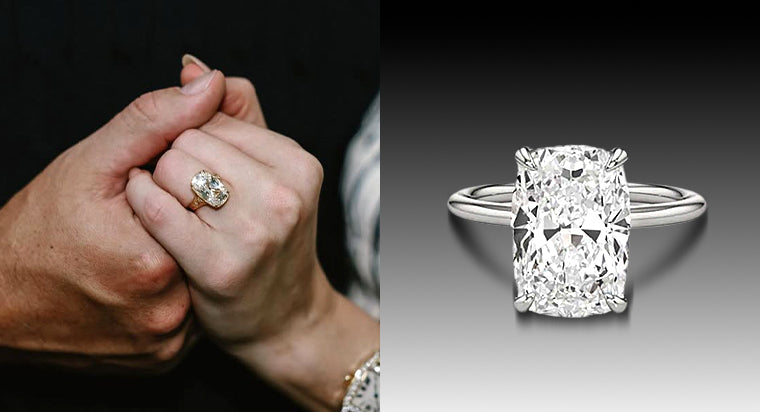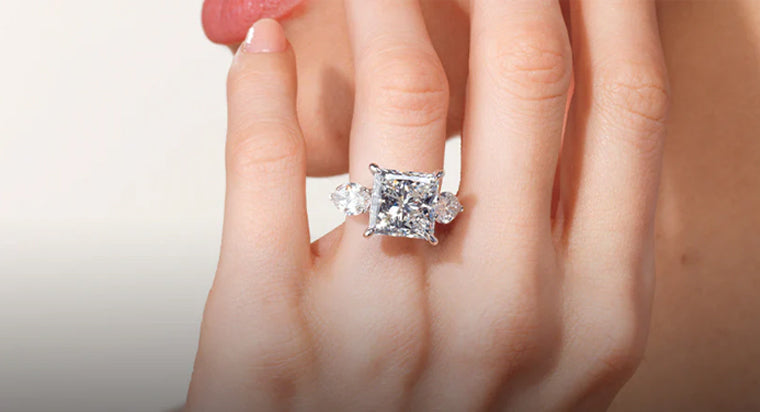The Process of Creating a Custom Engagement Ring: From Concept to Completion

More men and women choose to design their own custom engagement rings. Keep reading if you're curious about creating a custom ring. We'll cover all you need to know about the process, including the initial consultation, the design phase, material selection, finishing touches, and how to care for and maintain your gorgeous ring.
TABLE OF CONTENTS
Initial Consultation
The first step in a custom design process is an initial consultation. You'll want to find an established, reputable jeweler who is experienced in creating custom engagement rings. Your ring is a sentimental piece of diamond jewelry, and you want it to be high quality so it'll last. Be prepared to share your vision for your ring. This can be a sketch, photos, ideas, a vision board, or your thoughts about what your ring should look like. Some couples create an inspiration board on platforms like Pinterest or Canva to collect ideas. Part of this initial process is to discuss your budget. It's helpful in many ways to set a realistic budget. Factor in metal type, gemstones, design complexity, and size of the center stone into your budget.
Design Phase
The jeweler will create a sketch or digital rendering during the design phase based on your initial consultation. This is a rough draft based on your ideas. The design phase is a collaborative process where you can ask questions, adjust the initial sketch, and provide feedback. This is your chance to voice what you like and don't like about the sketch and make it your own. You and the jeweler are a team!
Once your ring looks like what you envisioned, it's time to approve the final design and move to the next step. Remember that the design step is your chance to tweak the design to ensure your ring is exactly what you want.
Choosing the Materials
The next step in the design process is to select the specific materials you'll use. First, you'll need to choose the metal. Typical engagement ring metals include platinum or gold (rose, white, or yellow). Some prefer alternative metals such as palladium, tungsten, or titanium. Each metal has its own characteristics and price tags. Platinum is a rare, dense metal that costs more than other metals.
Now it's time to choose the gemstones for your ring. Diamonds are common for engagement rings, but some couples want to include colored gemstones or use a durable stone, such as sapphire, as the center stone. Regardless of which gemstones you choose, you must consider the stone's quality. For natural or lab grown diamonds, the 4Cs (carat, clarity, color, cut) impact the quality and the price of the sparkling stones. Quality is also essential for colored gemstones - the hue and saturation are crucial.
Creating the Ring
Creating the ring is an exciting step. Jewelers use Computer-Aided Design (CAD) software to create a detailed 3D model of your ring, which allows for precise customization and visualization before production. Once the CAD model is approved, the jeweler crafts a wax model that provides a tangible design preview. This wax model is then used in the casting process, where it is encased in a mold. Molten metal is poured into the mold, replacing the wax as it melts away and solidifies into the final metal ring. This method ensures accuracy and intricacy in the finished piece, bringing the digital design to life.
Setting gemstones into a ring is a meticulous process that requires precision and skill. First, the jeweler prepares the ring by creating tiny prongs, bezels, or channels to hold the stones in place securely. Each gemstone is then carefully placed into its setting, ensuring it's perfectly aligned and snug. The jeweler uses specialized tools to gently tighten the setting around the stone to secure it without causing damage. This careful attention to detail ensures the gemstones are not only beautifully displayed but also held firmly in place.
Finishing Touches
During the finishing phase, your engagement ring gets polishing, detailing, and engraving, if applicable. Polishing and detailing a ring involves several steps to achieve a smooth, shiny finish and add intricate designs. The jeweler starts by using progressively finer abrasives to remove any scratches or imperfections on the ring's metal surface. This is followed by buffing with polishing compounds to produce a high-gloss shine. Then, any intricate details, such as milgrain edges or filigree patterns, are carefully added using specialized tools.
Some couples like to have the inside of the ring engraved for a personal touch. Engravings are custom messages, dates, or initials that add a personal touch and make the ring even more meaningful.
Quality Assurance
The final stage is quality assurance. Your custom engagement ring is thoroughly inspected to ensure all the stones are safe and secure and meet the jeweler's quality standards. Minor adjustments can be made at this stage if needed, but major changes aren't possible.
Aftercare and Maintenance
Caring for and maintaining your ring is essential to keep it looking its best and helps ensure it lasts for years. Regularly clean your ring with a soft brush and mild soap to remove dirt and oils. Store your custom engagement ring in a soft pouch or jewelry box to prevent scratches. It's also crucial to have regular check-ups with a jeweler to ensure the stones are secure and the metal setting isn't damaged. Professional cleanings and inspections can help catch any issues early, keeping your ring in optimal condition for years to come. Avoid wearing your ring during heavy activities or when using harsh chemicals to prevent unnecessary wear and tear.
With Clarity specializes in custom engagement rings. Book you appointment today and get in touch with expert gemologists and experienced designers to build your lab grown diamond engagement ring from scratch.









